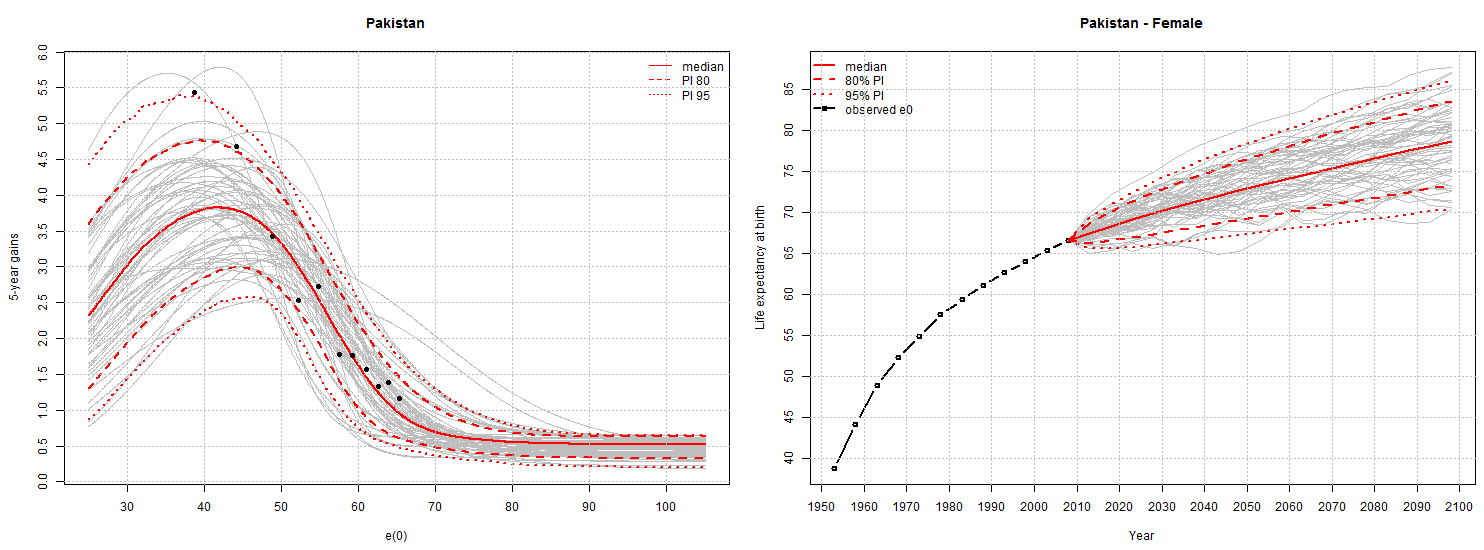United Kingdom and United Nations
population projections (cont.)
Mortality forecasts – United Nations
Starting with the 2012 release of World Population Prospects, the United Nations Population Division (UNPD) has adopted a probabilistic method for forecasting future rises in life expectancy at birth (Raftery et al. 2013). The gain in the life expectancy of women in each five-year period is modelled as a function of its level using a Bayesian Hierarchical Model to fit a double-logistic curve to existing estimates of life expectancy in the country and obtain country-specific distributions for the parameters of the decline. Both historical trends within the particular country and the world's experience are used to inform the model.
Then 100,000 forecasts of life expectancy are made for each country based on random draws from the probability distribution for each of the parameters of the fitted model. The median of these trajectories is taken as the principal forecast for the country and their distribution is used to calculate 80 per cent and 95 per cent projection intervals for future life expectancy at birth in the country.
![]() Click on the image below to enlarge it.
Click on the image below to enlarge it.
Probabilistic trajectories for the 5-year gains in life expectancy at birth and the resulting forecasts of life expectancy at birth of women (2010-2100) in Pakistan.
NOTE: For clarity, only a sample of the 100,000 trajectories is displayed. The median projection is the solid bold red line, and the 80% and 95% projection intervals are displayed as dashed and dotted red lines respectively.
Source: United Nations, Department of Economic and Social Affairs, Population Division (2013). World Population Prospects: The 2012 Revision
Men’s life expectancy at birth is forecast based on a deterministic model of the gap between the life expectancy of the two sexes by subtracting the forecasts of this gap in the fitted model from the forecasts of women’s expectation of life.
In countries with reliable mortality statistics, UNPD assumes that, as life expectancy increases, future survivorship by age evolves from its current values toward the pattern in an appropriate United Nations or Princeton model life table. For countries that lack reliable data, age-specific mortality and survivorship are estimated from the forecast values of life expectancy at birth using model life tables for the entire period of the projection.
For the 2012-based projections, the mortality impact of the HIV epidemic was modelled explicitly in 39 countries where UNAIDS estimated that the prevalence of HIV infection at ages 15-49 has exceeded 2 per cent.
Modelling of the prevalence of HIV infection and mortality from AIDS was based on a set of epidemiological assumptions developed by the UNAIDS Reference Group on Estimates, Modelling and Projections, details of which have been published in a 2010 supplement ![]() of Sexually Transmitted Infections. Because UNPD produces projections with a much longer time horizon than UNAIDS, it has developed assumptions of its own about the waning of the HIV epidemic and the longer-term impact of improvements in the coverage and effectiveness of therapy.
of Sexually Transmitted Infections. Because UNPD produces projections with a much longer time horizon than UNAIDS, it has developed assumptions of its own about the waning of the HIV epidemic and the longer-term impact of improvements in the coverage and effectiveness of therapy.
